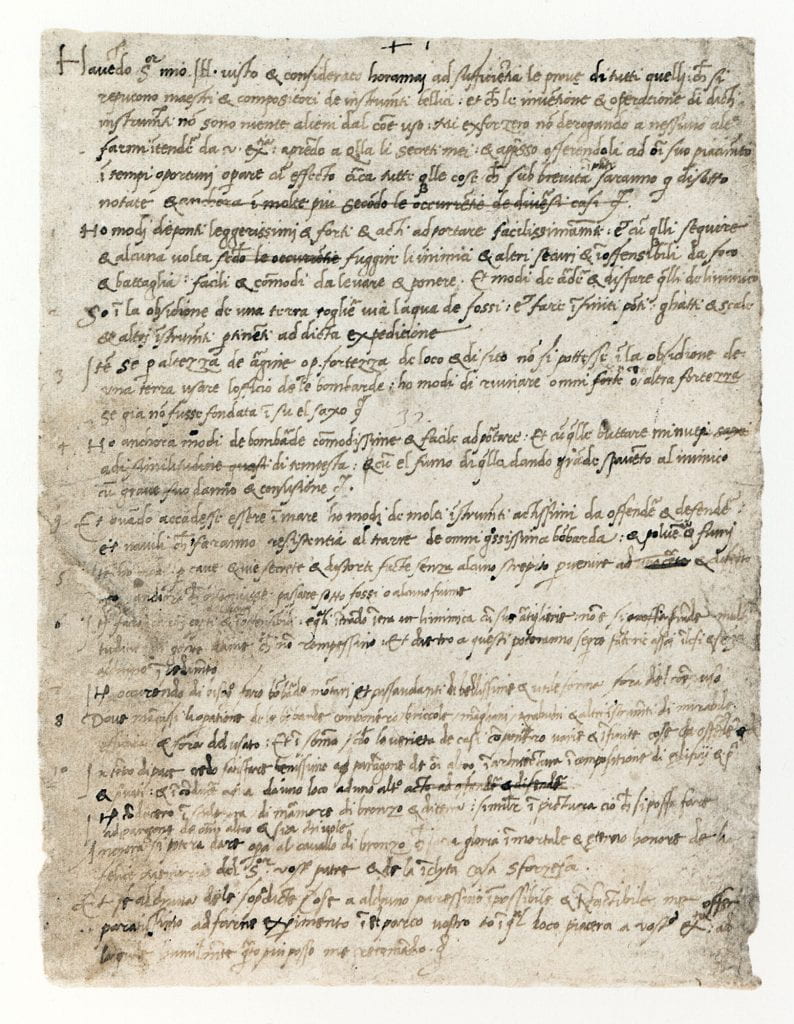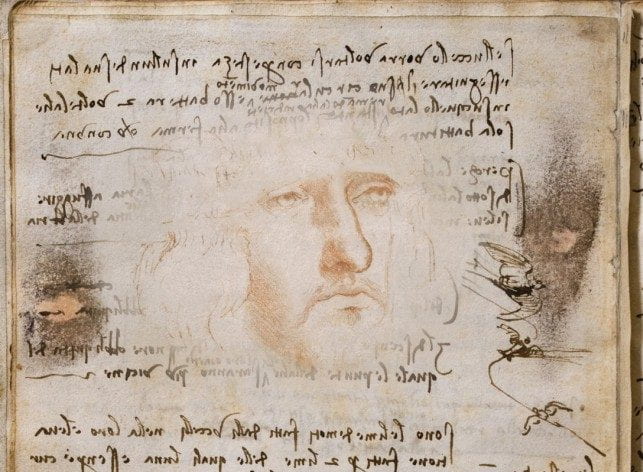By Luna Sarti
The over 3.5 million Italians who were watching the episode on Leonardo da Vinci in the popular historical program Ulisse probably rejoiced as much as I did to the news that Leonardo da Vinci had to write a CV. After an initial moment of joyful relief in the perception of such a shared experience across the centuries—if even a genius had to write a CV!—I started delving into the history of the Curriculum Vitae as a genre in professionalized labor, thus speculating on the practices it might entail as a nodal site between narrative, identity, and conceptualizations of work.

Often an obvious element in any job application, the Curriculum Vitae is an interesting textual genre which offers insights into the relationship between individual experiences and socio-economic structures as the writer fashions a document which is supposed to represent an equitable token to successfully navigate those very structures. Although a comprehensive history of the genre seems yet to be written, Leonardo da Vinci is often popularly credited as having crafted the first CV. Truly enough, the Codex Atlanticus, conserved at the Biblioteca Ambrosiana in Milan, includes the draft of a letter that Leonardo wrote in his 30s to Ludovico Sforza, ruler of Milan, with the intent of securing a position at his court.
Despite being formally shaped by different criteria if compared to our contemporary expectations of what a CV should look like, it is interesting to note that this letter of service is often interpreted through the modern perception of the Curriculum Vitae. As Leonardo introduces himself to Ludovico, in fact, he engages with strategies for constructing and presenting his own professional persona in a particular occupational context. He accordingly rearranges past experiences, acquired skills, and imagined scenarios in a narrative that responds to the ruler’s possible expectations and desires. In this text, which operates in the tradition of patronage letters, Leonardo fashions himself as a military engineer who can occasionally work as a painter, an architect, or a sculptor.
To my knowledge, most of the work on the modern CV is situated within sociological studies and focuses on its relation to notions of labor and education in late capitalism. Scholars in the field agree in identifying a lack of historical research on the genre while recognizing in Leonardo’s letter a possible origin and highlighting the 1950s as a turning point in the meaning and function of CVs. Although historical analyses of the CV as a textual form and as a contemporary idea are still sparse, there seems to be a shared commonsensical perception of such a history, which is very popular with websites and institutions dealing with strategies to produce CVs. The UK National Career Service, for example, produced an infographic that highlights the salient points of such a history, which starts with Leonardo and culminates with the development of a Lifelong Learning Account.
As Eva Forsberg discusses, the CV acquired its central, fundamental, and axiomatic role for those seeking to enter and to move within structures of education and labor during the second half of the 20th century, when a new society emerged “in which access to a given occupation was determined (supposedly) neither by family background, nor social status, but formal merits.” Within this context, a CV is asked to function as a rational, quantifiable token that highlights achievements and thus guarantees equitable access to the structures of work and socio-economic success. It could be argued that the CV as a genre thrives on the tension between self-narration and assessment, thus constituting a form for organizing, packaging, and mediating content in a way that supposedly guarantees, thanks to quantifiable parameters, a “fair” selection between applicants.
Focusing on the tension between self-narration and assessment, Nod Miller and David Morgan have proposed a reading of CVs through the lens of Goffman’s influential work on performance, thus concluding that the meaning of a CV occurs at the intersection between self and audiences who “share a common culture and a common set of rules and expectations.” From this perspective, they view the rules that govern CV-writing as being shaped “in conformity with commonsensical constructions of individual life-courses as well as with administrative understandings of experience and expertise.”
Although situating the origin story of the genre in Leonardo’s text involves some methodological issues, it is a helpful starting point for reflecting on the construction of the CV as a textual genre whose story is entangled with the historical development of education, labor, and class. Leonardo’s text, in fact, widely evokes the contemporary CV because it activates some of the expectations we recognize as governing this particular genre today. From this perspective, the fact that a 15th-century letter of presentation can be conflated with the category of the CV provides us with the opportunity to unravel some of the implications in those “commonsensical” rules that govern the production of a contemporary Curriculum Vitae.
In his popular work Fortune is a River, Roger Masters refers to the letter to Ludovico Sforza in relation to Leonardo’s struggle with socio-economic conditions and his attempt to secure an independent source of income that could support his household and his research (36-37). In this context, the letter takes on a different meaning and shifts from the glorious position it gains within the origin-story of a modern genre toward a less appealing one. The practices of self-fashioning that it underpins in relation to the audience’s expectations acquire new significance as they overlap with cartographies of power and socio-economic hierarchies. Whose language and values is Leonardo using in the narrative? His own or the Duke’s?
The rules of CV-writing require both the writer and the audience to engage with a particular conception of the past in which individual experience is rationalized by extracting certain valuable portions while striving for authenticity and excellence. As Chan, Johns, and Moses describe in Academic Metrics and Positioning Strategies, “the writing and tweaking of a CV is at once an exercise in self-appraisal, a response to past appraisal, and a task undertaken in anticipation of future appraisal.” (187) In its ideal form, the construction of a modern CV is supposed to quantitatively and qualitatively structure experience, thus facilitating objective comparisons between candidates in relation to potential employment. In the implicit engagement between the applicant-performer and the imagined evaluating audience, the practice of CV writing involves silencing as much as selective storytelling. As scholarship on the sociological significance of CVs in academia highlights, the production of CVs is rule-governed and institutionalized. Thus, investigating what criteria shape the rules and how they have been historically produced constitute the preconditions for asking whether these institutional practices really guarantee equality or rather contribute to reinforce existing power cartographies while relying on a widespread intellectual representation of a CV as a commonsensical parameter for equity.
At first, I started reading Leonardo’s letter with the hope he would mention the maestri d’acqua (water experts) while talking about his work as a hydraulic engineer. Then, I was amused by his witty manipulation of biography aiming to self-fashion a more effective persona in order to secure a position. It seemed to be an instance of how remarkably talented individuals can overcome the challenges of their time and live successful lives. However, wary of the controversial making of success stories, I started thinking about the history and implications of CV-writing. Now, I propose the question: is the contemporary iteration of professional self-fashioning deployed in the CV really a token for justice and social mobility?
Luna is a Ph.D. candidate in Italian Studies at the University of Pennsylvania and a primary editor at the JHI Blog.
Featured Image: Leonardo da Vinci, Self portrait. The Flight of Birds Codex. Raitre. WikiArt.




